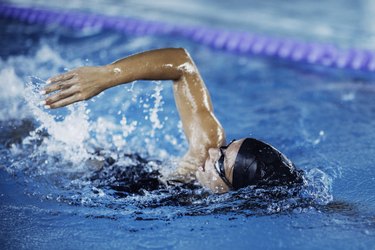
Swimming is a low-impact way to exercise, making it ideal for those with challenges for weight-bearing forms of movement. The calories burned in swimming pools are similar to the caloric burn from running. However, how many calories you'll burn depends on the stroke you swim, the amount of exertion and even how much you weigh.
Read more: 162 Swimming Statistics You Should Know
Video of the Day
Video of the Day
Why Meters Matter
Pools in the U.S. are constructed for overall length in either meters or yards. Swimming 1,000 meters equals just under two-thirds of a mile; swimming 1,000 yards is just over a half-mile.
An "Olympic-sized" competition pool is measured in meters and must comply with regulations set by the Fédération Internationale de Natation (FINA), the international organization that maintains worldwide rules for competitions worldwide. The Olympics are held in pools measuring 50 meters in length by 25 meters in width; however, the World Finals take place in a 25-meter pool. Which you work out in will also affect how many calories you burn as turns in the shorter pool allow your body a rest period.
When working out in a "short course" pool, ask whether it is 25 meters or 25 yards as the length difference isn't easily noticeable. You can still swim 1,000 meters in a 25-yard pool; you'll need to swim 44 lengths of the pool instead of 40 to go the distance. If you're swimming in a "long-course" 50-meter Olympic-sized pool, you'll need to do 20 lengths of the pool to make up the distance.
Plan Your Workout
Choose from one of the four competitive strokes in swimming to plot out your 1,000 meters. Swimming, in general, burns 360 calories per hour for a 125-pound person according to Harvard Health Publishing. However, each stroke is different, depending on its overall intensity.
Butterfly and freestyle — also known as front crawl — deliver the highest intensity, according to Harvard Publishing. People who are 125 pounds will burn roughly 660 calories, and those who are 185 pounds can expend 976 hourly.
Read more: 7 Tips to Become a Better Swimmer
Breaststroke is the next best. The full-body, symmetrical stroke zaps up 600 to 888 calories, depending on whether you weigh closer to 125 or 185 according to Harvard Publishing. Backstroke might not seem most natural, as many people have discomfort with not being able to see where they're going. However, it takes the fewest calories at just 440 to 710 per hour, depending on your weight.
Check Your Speed and Intensity
Of course, the actual amount of calories you burn per hour will depend on the distance covered. A pace of 1 mile per hour swimming breaststroke at moderate exertion works out to 15.25 calories burned in swimming pools for every 50 meters you swim according to a swimming calories-burned calculator by Nanyang Technological University. That amounts to 305 calories consumed by your body throughout 1,000 meters.
Read more: 7 Cross-Training Workouts to Shake Up Your Routine
Your average swimming speed matters. The same moderate pace swum freestyle at 2 miles per hour uses up 24.51 calories over the same distance, totaling just over 490 calories for 1,000 meters. Increase your speed to 3 miles per hour, and the increased intensity burns up 47.15 calories for every 50 meters swum. That means a 1,000-meter caloric outlay of 943, nearly 1 calorie for every meter swum.